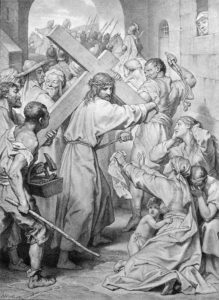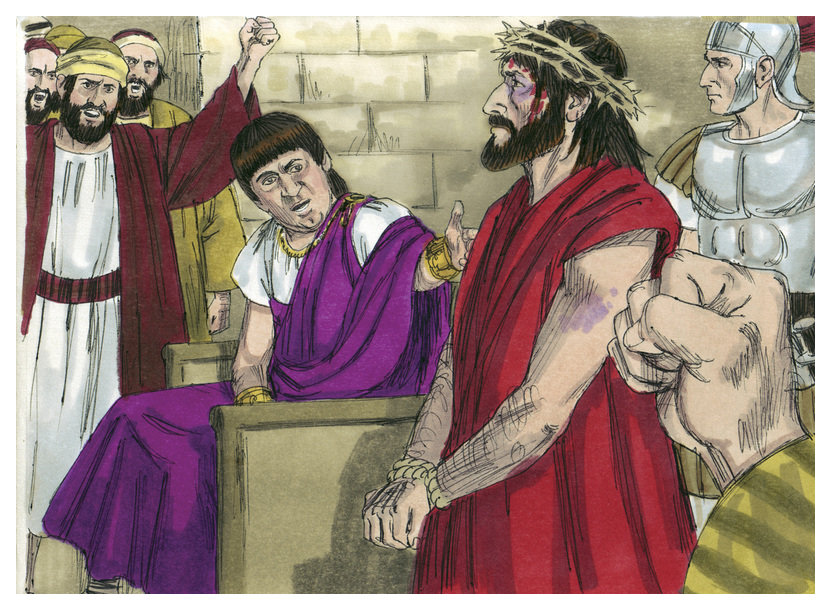John 19 reveals Jesus’ final hours; from his meeting with Pilate to his suffering upon the cross, the confirmation of his death and ending with his temporal burial in Joseph of Arimathea’s tomb. However, in order to fully understand the events within this chapter, one must review how Jesus came to be in the hands of Pilate from the Jews in John 18.
In the previous chapter of John, Judas Iscariot has handed Jesus over to the authorities to be condemned. Peter was violently against the guards taking away his Lord that he cut off one of the soldier’s ears. Jesus healed the soldier right there, nonetheless, the soldiers bound him and took him away. Amazing that this final miraculous healing didn’t deter the evil intents of Jesus’ enemies completely.
The 18th chapter explains Jesus’ secret trial by Annas, then Caiaphas (the Jewish high priest at the time) as the precursor of his being sent away to Pilate so that he could sentence the Christ to death.
“Then they brought Jesus from Caiaphas into the Praetorium (judgment hall, governor’s palace). And it was early. They themselves did not enter the Praetorium, that they might not be defiled (become ceremonially unclean), but might be fit to eat the Passover [supper]” (John 18:28, Amplified).
What the History of Israel Reveals
Studying the history of Israel reveals that the Jewish leaders, being under the earthly rule of the Roman Empire, held no real authority to condemn any man to death on their own. In order to kill Jesus, they had to plead with Pontius Pilate (then governor of Judea) for sentencing in their favor. Also, the Jewish community was in the middle of observing The Passover. By entering a place of violence and death (the Praetorium where Pilate would later have Jesus flogged) would make any Jew unclean and unable to observe this required holy week so the Jewish leaders could not defile themselves with Jesus’ blood.
Therefore, unwilling to enter the governor’s palace and unable to kill Jesus themselves, the Jewish leaders have quite a time convincing Pilate that he should actually sentence Jesus to death. Up through the conclusion of John 18, Pilate finds no fault with Jesus worthy of death. However, he is also a man in charge of keeping the peace in Judea. And since others before him had failed to do so to the satisfaction of Caesar, Pilate attempts to appease the now loud and soon-to-be unruly Jewish crowd by having Jesus flogged.
“So then Pilate took Jesus and scourged (flogged, whipped) Him. And the soldiers, having twisted together a crown of thorns, put it on His head, and threw a purple cloak around Him” (John 19: 1-2, Amplified).
 Flogging is no small punishment. In the time of Jesus’ death, Roman flogging was commonly used as a violent warning against illegal behavior to discourage further disobedience of the law. Tradition held that 39 lashes could be delivered as the maximum punishment without actually killing a man. Though the exact amount of lashes is not given in John 19, due to Pilate’s superstition and scared position in relation to the Jewish community leaders, many Biblical scholars believe that this max was administered to Jesus along with his other physical maltreatment and ridicule by the Roman guards.
Flogging is no small punishment. In the time of Jesus’ death, Roman flogging was commonly used as a violent warning against illegal behavior to discourage further disobedience of the law. Tradition held that 39 lashes could be delivered as the maximum punishment without actually killing a man. Though the exact amount of lashes is not given in John 19, due to Pilate’s superstition and scared position in relation to the Jewish community leaders, many Biblical scholars believe that this max was administered to Jesus along with his other physical maltreatment and ridicule by the Roman guards.
Then Jesus came out, wearing the crown of thorns and the purple robe. And Pilate said to them, “Behold the Man!” (John 19:5, NKJV)
The flogging was not enough for the Roman soldiers. They had to mock Jesus’ kingship, not knowing that they were making fun of the actual Son of God. Purple is a royal color and the thorns were placed upon his head in a mock crown, inflicting even more pain on the Christ.
And yet the Jewish leaders’ thirst for Jesus’ blood was not satisfied. In verses 6 and 15, they cry out for Jesus to be crucified. Now the Jewish leaders held no authority during this period to actually have a man killed. Under Roman control, only the governor (or Pilate) had that authority. However, they were crafty in getting Pilate to do their evil deed for them. By appealing to his fear of defying Caesar while sticking to the traditions of the Jews under his command, they forced Pilate’s hand. Even though he feared that Jesus was divine ( having claimed to be the Son of God), he feared losing control of the ever-intensifying mob before him and, therefore, handed Jesus over to be crucified.
The sign for Jesus created by Pilate
In accordance with tradition, Pilate created a sign for Jesus’ cross-bearing his “crime.” Every criminal who was crucified had his crime added to his cross for all to see.
“Now Pilate wrote a title and put it on the cross. And the writing was:
JESUS OF NAZARETH, THE KING OF THE JEWS.
Then many of the Jews read this title, for the place where Jesus was crucified was near the city; and it was written in Hebrew, Greek, and Latin” (John 19: 19-20, NKJV).
And though the Jewish leaders protested Pilate’s wording of this title, he did stand firm.
While the Gospel of John is not the only one to record the death of Jesus, it is unique in its addition to Jesus’ transfer of protection over his mother to his disciple John. During this time, a woman needed to be under a man, not only for protection but also for provision. Since John was the only male disciple who accompanied Jesus’ mother to the cross (all others had fled into hiding) he was given the privilege of taking Mary as if she were his own mother.
Then He said to the disciple, “Behold your mother! “And from that hour that disciple took her to his own home (John 19:27, NKJV).
Verses 31-37 confirm the validity of Old Testament prophesies concerning his death. Normally, death by crucifixion was a long agonizing process. Jesus, though, having endured such inhumane torture since the previous night on up through his placement upon the cross, died before the ending of the day. The other two men crucified with him had their legs broken to speed up their suffocation.
John 19 concludes with a secret disciple of Jesus, one Joseph of Arimathea, offering up his own tomb for Jesus’ burial. Also, Nicodemus (another secret believer of Jesus as the Christ) came and wrapped up his body according to the Jewish customs.
“So there they laid Jesus, because of the Jews’ Preparation Day, for the tomb was nearby” (John 19: 42, NKJV).
Though chapter 19 ends here, the story of Jesus doesn’t. His death is only the beginning.






